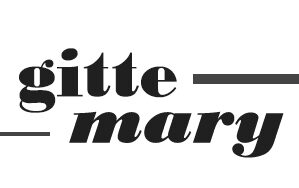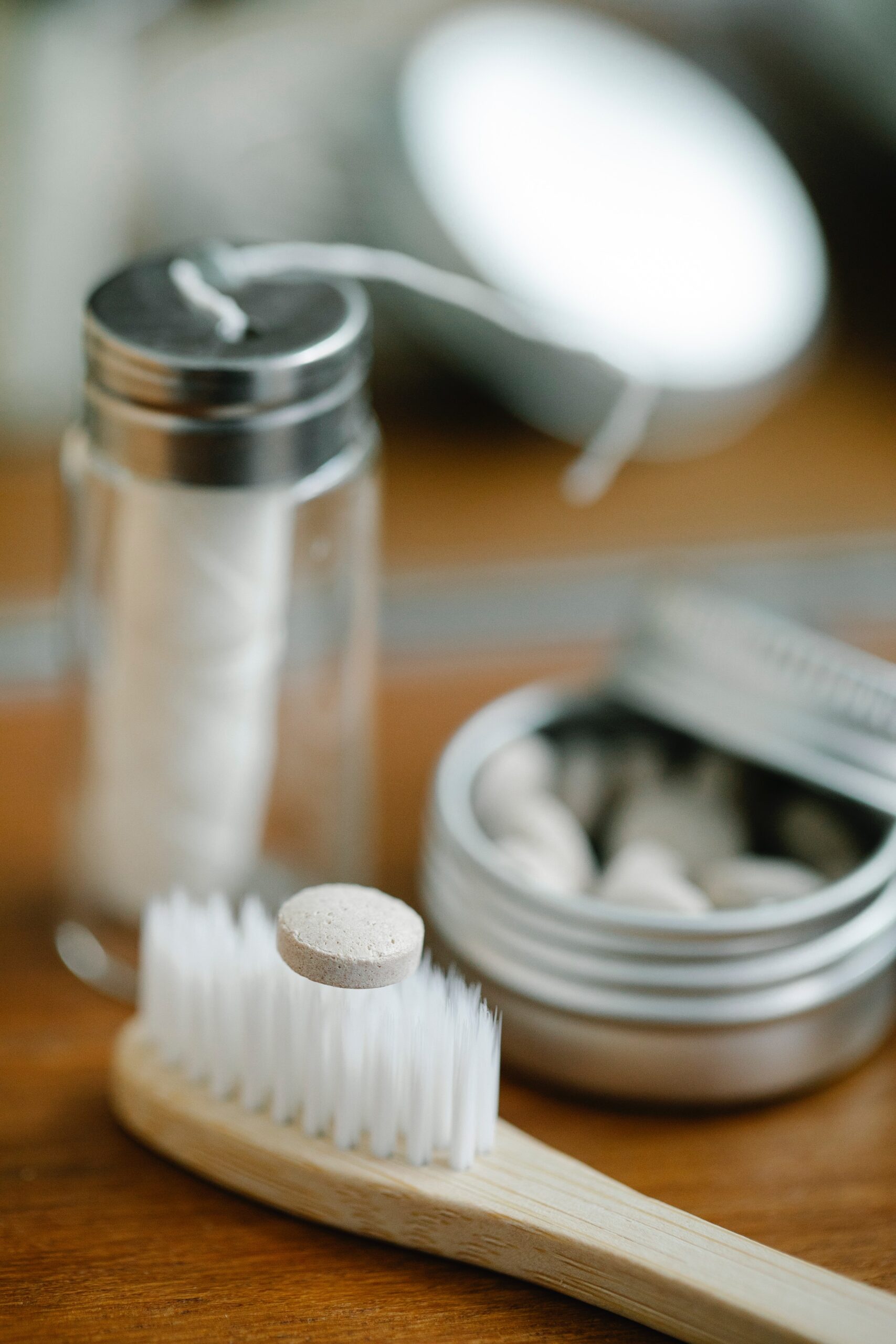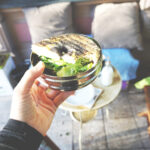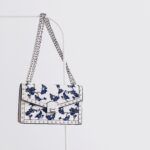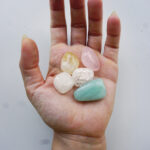When I started my zero waste journey, toothpaste was one of the things I very quickly realised that I had to change, because my toothpaste came in a plastic, unrecyclable tube. Yikes.
My first solution was homemade toothpaste, but for so many reasons, I stopped doing that pretty quickly, it doesn’t work in terms of preventing cavities, and it was also just gross. My next solution with toothtabs, and it has actually been my preferred solution for years. I get my toothtabs primarily from Denttabs, and I love them, they contain fluoride and are super easy to travel with. And I have been able to find them either in bulk or in minimal packaging, so overall a big win for the planet, right? But sometimes, the products that feel, and look sustainable, aren’t necessarily, so I decided to actually find out if my zero waste alternative is actually any better than the conventional option, so let’s get into it.
First of all, toothtabs are a compressed powder derived from stuff like xylitol (a natural sweetener that also fights oral bacteria), calcium carbonate (a chemical compound found in limestone and snail shells), and sodium bicarbonate (standard baking soda). They often also contain cream of tartar, a common household bleach alternative made from tartaric acid. Typically, toothpastes contain water (20–40%), and abrasives (50%) including aluminum hydroxide, calcium hydrogen phosphates, calcium carbonate, silica, and hydroxyapatite.
While there is a lot to be said about ingredients, from an environmental point of view, one of the main issues with toothpaste is packaging. While enterprises like TerraCycle accept oral care products, plenty still end up in landfills. Actually, around 1 billion toothpaste tubes end up in landfills each year. Moreover, many toothpastes – roughly half according to Dutch NGO Plastic Soup Foundation’s Beat the Microbead campaign – also contain microplastics. With these types of facts, it seems like toothtabs are a no-brainer.
Then I stumbled upon this life cycle assessment report from a researcher in Thailand, from 2022. “A Comparative Life Cycle Assessment of Toothpaste Cream versus Toothpaste Tablets”, there is very little data on toothpaste vs tooth tabs products and their impact, so we’ll be using this report as our primary source for our analysis, but I have some comments here and there in terms of how their studies were conducted.
Also check out: ZERO WASTE DENTAL HYGIENE // toothbrushes, toothpaste, floss, and more
INGREDIENTS
Strangely enough, the LCA assumes that the toothpaste is made from ingredients a lot more local than those of the toothtabs. I assume that specific products have been used in this analysis, but of course, it is possible to find toothtabs made more locally, as well as toothpaste made thousands of miles away, and I think that’s important to keep in mind as transportation accounts for a significant part of the overall impact, in this instance.
Toothpaste: The study describes how “all of the raw materials (of toothpaste) are transported locally by pick-up trucks from suppliers to the factory with a total distance of about 100 km, (…) Finished products are transported and stored in the warehouse 50 km away from the factory for less than 30 days and then distributed to retailers by a 40 ft trailer truck with a total transportation distance of about 100 km.”
Toothtabs: “First, organic raw materials are purchased and transported locally by 10-ton trucks from many sources with a total transportation distance of about 90 km and then go through a dry mixing process in the factory. They are pressed in a mold to turn the mixed ingredients into a pill-like form. Moreover, the desiccants made from calcium aluminosilicate or bentonite clay and paper package materials are imported from China by plane and then packed into a small packet in Thailand. The desiccant packets are transported by a pick-up truck about 50 km to the toothpaste tablet distribution center for a further logistic procedure”
I gotta say, these descriptions made me doubtful of the whole report, it seems like they are talking about two specific products and not types of products in general. Otherwise, why would one truck be described as a “40 ft trailer truck” and the other as a “ten-ton truck”? Very specific, and it seems unlikely that no toothpaste packaging ever has been shipped from China via plane, so we’ll keep that in mind when we draw conclusions.
In terms of local production, this isn’t universal for all brands, Colgate is tubed in either the US or Mexico, Jordan toothpaste is tubed in China, India, or Malaysia, while Denttabs is manufactured in Poland. While it is most likely that the vast majority of large commercial brands source at least *some* ingredients from China. Ultimately, it is fair to assume that the more ingredients a product contains, the more likely it is to have a big sourcing impact, but there are millions of variables here, which the LCA also acknowledges.

USAGE
This study accounts for an impact based on the usage of toothpaste and toothtabs for 6 months, where the product is used twice a day. It acknowledges 1 tube of toothpaste and 5 refills of a 60-tablet jar. What I find odd is that the LCA includes the impact of letting the water run for a full 2 minutes each day, while the teeth are being brushed. This is strange, but maybe it is an expression of typical consumer habits, and if so, can we please stop this now? This was honestly something that threw me for a spin, does people actually let the water run when they brush their teeth, please bestie, stop that. The study uses a tablet measuring 0.7 g, and a comparable size of toothpaste, but of course that is a lot more difficult to measure, as it is difficult to squeeze out the same amount of toothpaste each time, so there is a variable there. The study shows “about 0.25–0.4 g for each usage of toothpaste among adults (McMahon, 2019; Thornton-Evans et al., 2019)” So the sample amount of toothtabs is actually twice as high, but also impossible to reduce.
“After 6 months, the empty glass has been reused for about five times or will be recycled at the end of life.” While the 1 tube of toothpaste made from HPDP plastic was sent to landfill.

THE STUDY
It’s difficult to measure sustainability because it consists of many different factors. The method used in this study is ReCiPe, and it measures impact based on certain parameters. The study compares toothtabs and toothpaste based on their impact on the damage impacts to human health, ecosystems, and resources; and 11 characterization factors, namely:
- global warming
- freshwater eutrophication
- marine eutrophication
- terrestrial ecotoxicity
- freshwater ecotoxicity
- marine ecotoxicity
- human carcinogenic toxicity
- human non-carcinogenic toxicity
- mineral resource scarcity
- fossil resource scarcity
- and water consumption
The LCA results showed that using toothpaste tablets slightly contributed to a higher score in all damage categories than using toothpaste cream. Brushing teeth for 2 minutes twice a day for 6 months with toothpaste tablets accounted for 188 milipoints, while brushing with toothpaste cream was 163 millipoints. This is measured in milipoint, which is a unit of measure from ReCiPe, a method of calculation in LCA, so it’s basically the “sustainability score” given to the products based on collected data.
Cleaning teeth with a toothpaste tablet caused a serious environmental burden in all midpoint impact categories, except for freshwater and marine ecotoxicity, human non-carcinogenic toxicity, and water consumption.
Impact category Unit Brushing teeth with toothpaste cream // Brushing teeth with toothpaste tablets
Global warming kg CO2 eq 2.922 4.200
Freshwater eutrophication kg P eq 0.002 0.003
Marine eutrophication kg N eq 0.008 0.008
Terrestrial ecotoxicity kg 1,4-DCB 6.236 6.522
Freshwater ecotoxicity kg 1,4-DCB 0.173 0.103
Marine ecotoxicity kg 1,4-DCB 0.235 0.142
Human carcinogenic toxicity kg 1,4-DCB 0.348 0.355
Human non-carcinogenic toxicity kg 1,4-DCB 5.542 4.011
Mineral resource scarcity kg Cu eq 0.015 0.023
Fossil resource scarcity kg oil eq 0.880 1.104
Water consumption m3 0.117 0.116
For toothpaste: almost 80% of the impact was significantly contributed from the use phase, whereas the remaining impact was divided like so:
- raw material acquisition (10%)
- production phase (about 5%)
- end of life (about 5%)
- transportation (less than 1%).
For toothtabs: about 65% of the impact was obtained from the use phase, whereas the remaining impact was divided like so:
- 20% of the impact was from raw material acquisition
- followed by production (4%)
- transportation (less than 1%).
Furthermore, the end-of-life of glass recycling showed a 10% positive impact contributed to the entire product life cycle.
RESULTS
As always, the impact of the product can be divided between manufacturers, and users (and those who dispose or recycle it). And the study suggests a few different things that can improve the impact of both toothpaste and tabs. Toothtab manufacturers should reduce the size of a toothpaste tablet, reconsider material sources, and explore other alternatives for raw material substitution for some of their inactive ingredients (SLS, PVP, mannitol, sorbitol, and magnesium stearate) to mitigate the impacts and enhance sustainable toothpaste production.
However, interestingly, how we use both toothpaste and tabs could be a defining factor. Looking at sustainable consumption, individual users play an important role. The dosage is uncertain depending on their behavior and preference. However, the considerate design of toothpaste packaging and dispensing can influence user behavior and help control the amount of toothpaste used. I don’t think this is rocket science, the longer your tube lasts, the better.
The study cannot control exactly the amounts of toothpaste they analyze, as it is different each time, how much toothpaste an individual uses, however, the amount is completely static for tooth tabs, at 0,5 g (some brands 0,7g) per tablet. The amount of products used per brushing is really important to determine impact. Furthermore, The British Dental Association (2021) showed that up to 10% of toothpaste still remains in the tube even when users think that the tube is empty.
The study writes: “Even though a plastic-free concept and reusable package have been applied in the case of toothpaste tablets, a major concern still exists from a vast amount of water consumed and wastewater generated during brushing and a high impact on ingredient production.” But maybe I am missing something here, but the in the study it is listed that the difference in water consumption between the two products is 0.001 m3, which I wouldn’t necessarily consider a “vast amount”.
Brushing teeth for 2 minutes twice a day for 6 months with toothpaste tablets accounted for 188 millipoints while brushing with toothpaste cream was 163 millipoints. Making toothpaste the more sustainable choice. However, when comparing the same weight of toothpaste cream and a tablet used at 0.4
g, the results showed that the environmental burden from toothpaste tablets dropped considerably to 154 mPt. So if the sample sizes of the two products are considerably more similar, the toothpaste tab comes out on top.

CONCLUSIONS
I wouldn’t expect most consumers to care about this at all, to be honest. I am most interested in the sourcing of materials, and I think it’s good that data exists that makes it easier for brands to make better decisions when designing their products so that consumers will have access to better options.
Based on this study, I don’t necessarily think that we can conclude that ALL toothpastes are better than ALL toothtabs, as there was some questionable sampling going on at the beginning of the methodology. But, the study did shed some light on the fact that toothtabs aren’t inherently better than conventional products, so it might pay off to make other, and more effective, swaps elsewhere in your home. However, I won’t toss my Denttabs, they’re still great for traveling, but I also sometimes use my Jordan toothpaste, and honestly, I think both options, and many others, are fine.
I would say, that the many impact differences between toothpaste and toothtabs are minor, and there are other aspects to consider that weren’t a part of the LCA, like microplastic for instance, but I think these are some pretty good pointers to go forward with:
- Turn off the water when you brush your teeth
- Make sure that the packaging is completely empty before discarding
- use small amounts to make the products last as long as possible
- Support local, or more local-ish manufactures
- Recycle and reuse packaging
- And be careful with products that offer “natural” alternatives to fluoride, this is sketchy and while fluoride isn’t supposed to be ingested (like shampoo), it is the most effective ingredient to prevent cavities, and it is recommended that you don’t opt for fluoride-free products, neither paste, nor tab.
